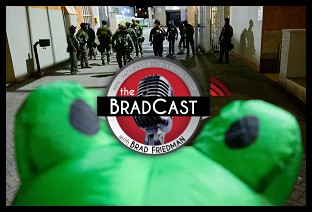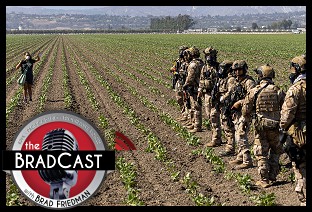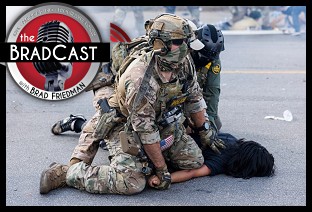READER COMMENTS ON
"Sisters of GOP IT Guru Mike Connell 'Very Suspicous' About His Death"
(27 Responses so far...)
COMMENT #1 [Permalink]
...
Larry Bergan
said on 5/2/2009 @ 12:30 pm PT...
Quick! Somebody subpoena Karl Rove so he can moon us again.
COMMENT #2 [Permalink]
...
Lora
said on 5/2/2009 @ 2:47 pm PT...
From the above Daily Page link:
The cause is still under investigation but is presumed accidental.
Umm, ok.....source?
COMMENT #3 [Permalink]
...
blubonnet
said on 5/2/2009 @ 10:17 pm PT...
Excellent , Larry Bergan. Yeah, who's to stop him? Congress...? They talk a big talk. Hell, war crimes are no big deal either around here these days of the failing states of democracy...What's a little murder? #!@#*& Nothing that a bag of potato chips and a gallon of vodka can't make go away for the average American!
COMMENT #4 [Permalink]
...
Floridiot
said on 5/3/2009 @ 3:18 am PT...
On Wellstones co-pilot that fateful day:
[...] His co-pilot, Michael Guess, was not as highly qualified, but he was a competent pilot for a plane that did not require two. Indeed, one of the ironies of the FBI’s announcement is that Guess turned out to have known Zacharias Moussaoui...
COMMENT #5 [Permalink]
...
Floridiot
said on 5/3/2009 @ 3:26 am PT...
Oh, and you probably want to read on in that link for more quotable quotes to see what happened to Connells plane, like:
The more I investigated the case, the more peculiar it seemed. An odd cell-phone anomaly was reported to me, where the driver, passing just south of the airport en route to the funeral the senator had planned to attend, heard a loud wailing and war-belling sound, unlike anything he had heard before. I contracted an Australian colleague, John P. Costella, who has a Ph.D. in electromagnetism, and asked him if this could have been an effect of the use of a high-tech weapon, which could take out all the planes electronics, including its navigation system, communication system, and stall warning alarm. It would turn out that the props were on idle when it crashed, which the NTSB was unable to explain. A directed-energy weapon could not only have taken out the plane’s electronics, including its communications and navigation systems, but flipped the solenoids that control the pitch of the props and set them to “idle”. The more that I studied the case, the more it appeared that the plane was not under their control. They had apparently been unable to stop it.
COMMENT #6 [Permalink]
...
Big Dan
said on 5/3/2009 @ 10:10 am PT...
Future headline: "IT guru who died in plane crash - his sisters who suspect foul play die in plane crashes and/or commit suicide"...
COMMENT #7 [Permalink]
...
Lora
said on 5/3/2009 @ 3:07 pm PT...
Big Dan,
Let us hope not.
About that investigation...can anyone get any updates on it?
COMMENT #8 [Permalink]
...
chris
said on 5/3/2009 @ 10:06 pm PT...
Big Dan.
You mean like the anthrax killer who happen to have the wrong strain of anthrax (DNA did not match) which was used in the attacks?
Thats conspiracy stuff.
COMMENT #9 [Permalink]
...
blubonnet
said on 5/4/2009 @ 11:26 am PT...
I've often wondered if Congress's failure to hold GOP criminals accountable, was due to often unspoken, yet actual threats to their lives. I can't help but wonder how often Barack Obama has considered the consequences of such things. I believe, being black is already dangerous, while being President.
COMMENT #10 [Permalink]
...
airline pilot
said on 5/4/2009 @ 8:54 pm PT...
well, my experience is that he suffered vacuum pump failure (sabotage likely) and that his plane was not equipped with a backup electric pump, and if it did have one, the wires to that were 'cut' so that when the vacuum sensor or the manual switch for it got the power due to vacuum loss, it didn't keep the artificial horizon gyro working and his partial panel (ability to fly on only some of his instruments) skills were not good enough to save him that flight.
N.T.S.B. is totally compromised, as they covered up the Sept. 11, 2001 stuff, so you can't expect their data on this crash to be any different. It'll all be totally covered up. I hope the family took possession of the wreckage and had it hauled off to a safe place as soon as possible.
COMMENT #11 [Permalink]
...
Floridiot
said on 5/5/2009 @ 1:50 am PT...
Pilot, nah, the family doesn't have control of it.
As I remember, the NTSB was shuffling it between hangars, someone had pictures of that happening at the time.
Link
COMMENT #12 [Permalink]
...
Airline Pilot
said on 5/5/2009 @ 1:43 pm PT...
Well, sounds like there'll be another 'cover up' and of course, they'll blame the pilot. I sure would love to hear the final A.T.C. transmissions between Connell and the Tower, assuming he was inbound on the ILS, inside the outer marker. Typically, if it was the vacuum pump that quit on him, and the artificial horizon gyro was 'dying', he'd have told A.T.C. about that, certainly he'd been aware of it because you tend to screw up really bad flying the spinning down horizon gyro into the ground then.
there are ways to see sabotage even post crash and though it is not uncommon for a vacuum pump to fail, it's happened to me a few times in my 30 plus year career flying all sorts of stuff. However, if he had an electrical backup system and that obviously wasn't working or he'd still be alive today, a decent forensics investigation can tell if that gyro was spinning on impact or not, as the deformation is significantly different for a non-spinning gyro versus one that is running at some R.P.M. value near nominal for it, before impact.
If I were the family, I would be pushing to get the wreckage released to them, and have an independent lab look at the vacuum gyro, and the electric backup system horizon gyro if that was on board that plane. I'd also be asking for copies of the final transmissions to A.T.C. from Mike before he augered in, as it was leaked early on that he'd intimated to A.T.C. that he was with some form of malfunction on board. Even if he lost his electronic navigation, his ILS localizer and glideslope capability, and his G.P.S., he could have asked A.T.C. to vector him for a 'no gyro' approach where they just give him right/left and climb and descend information, provided there was a P.A.R. (precision approach radar) somewhere in the area. A standard ASR-64 radar is not good enough for that, but a military PAR at an adjacent military facility would have saved his life. Flying partial panel is not fun for even someone who practices it alot, I can tell you that your first reaction is; "oh SH*T" and you absolutely must cover up the bad instrument or you'll incorporate that erroneous garbage into your corrections and you'll auger in. Turn and bank and compass and V.S.I. all would have been enough to keep him straight and level had he recognized a vacuum failure early enough.
Please tell his family to get the wreckage to a real investigator, get it away from the N.T.S.B. as soon as possible. They're compromised and no longer real. After their b.s. about TWA-800, as far as I'm concerned, they became 'fiction writers' strictly. Then, with their recreation of the Pentagon attack and FLT-77, they truly perjured themselves and committed really major 'felony' offenses there.
regards,
COMMENT #13 [Permalink]
...
Agent 99
said on 5/5/2009 @ 1:56 pm PT...
After their b.s. about TWA-800, as far as I'm concerned, they became 'fiction writers' strictly.
Amen, Pilot, amen.
COMMENT #14 [Permalink]
...
Airline Pilot
said on 5/5/2009 @ 3:40 pm PT...
this is the core of the N.T.S.B. final report on this accident. I have made my notes below the text, under the dashed lines.
On December 19, 2008, about 1753, a Piper PA-32R-301T, N9299N, received substantial damage on impact with terrain during a precision approach to runway 23. A post crash fire then ensued. The airplane impacted the front lawn of a vacant house about two miles east-northeast from Akron-Canton Regional Airport (CAK), Akron, Ohio. Night instrument meteorological conditions prevailed at the time of the accident. The pilot was fatally injured and there were no ground injuries. The flight departed from College Park Airport (CGS) College Park, Maryland, about 1531 and was returning to CAK at the time of the accident.
During the approach to CAK, N9299N asked whether there were any reports of icing to which air traffic control (ATC) responded that there were no reports. ATC then instructed N9299N to provide a report of icing if encountered. No reports were received by N9299N. Preliminary radar data shows that the airplane maintained assigned headings and altitudes while en route to CAK.
The airplane received radar vectors to the instrument landing system (ILS) approach to runway 23. The airplane was vectored to intercept the approach about two miles from the outer marker. The airplane was inbound from the outer marker when ATC advised N9299N that it was left of course. ATC asked if N9299N would like to be resequenced and N9299N responded by transmitting “correcting.” The airplane altitude was still about 3,200 feet (the intermediate segment altitude for the approach is 3,200 feet). ATC then advised N9299N that it was “well left of the localizer” and if it would like to be resequenced. N9299N responded by transmitting that it would “like to correct.” N9299N was about 2 ½ miles from the airport when it then transmitted if it could execute a 360-degree turn. ATC then instructed N9299N to climb and maintain 3,000 feet and queried N9299N’s present heading. N9299N transmitted, “heading due north and climbing.” N9299N then declared an emergency.
A witness reported that he was outside of his home when he first heard a “loud” engine sound from a small aircraft. The sound was coming from the north and sounded as though the pilot was trying to accelerate “rapidly.” Suddenly, the witness saw two bright lights coming almost nose first toward the ground with the engine “roaring.” Based upon the witness’ view of the lights, he assumed the airplane was flying west to east. He lost sight of the airplane when it descended below a tree line.
The pilot held a private pilot certificate with single-engine land and instrument airplane ratings. The pilot reported a total flight time of 510 hours at the issuance of his last medical certificate dated October 19, 2007.
---------
based on this, if there is any truth to the report at all, this pilot failed to adequately intercept the localizer (course track to the threshold, kind of like a vee shaped funnel, that gets narrower and narrower at the end) and based on the radio transmissions they have published, he did not cite that he had a navigation radio issue going on. Now, I can tell you that in this Saratoga, it would have had 'dual' Nav's in it, and it's very common for a pilot to set both to the same localizer frequency, the CDI knob strictly would have been set to the runway heading as a reminder, nothing more, as the localizer doesn't look at the CDI knob, only VOR does. Both course indicators, vertical white needles on the face of the displays, would have had to pretty much track with each other before I would personally continue an approach down to the missed approach point, or MAP. Now, typically if there is high terrain around, or the plane is not equipped with DME (distance measuring) or GPS for precision positional data, I would then have set the #2 nav. radio to an adjacent VOR and used a 'lead radial' set on the CDI knob to more or less help verify the MAP point was reached. It sounds like Mike failed to do what it takes to bracket the correction for the ILS LOCALIZER, did not join the localizer, and then, for some ungodly reason, asked to execute a 'turn' at low altitude in solid IFR conditions, which ATC would and did say 'nyet' to because they'd just re-sequence him for the approach and radar vector him after he climbed to 3000 feet, probably the minimum vectoring or MVA for the area, because they cannot be responsible for obstacle clearance for IFR Traffic until the pilot at least achieves the safe MVA for the area first. Then they would have given him headings back to the final approach course interception again.
Now, he asked about icing. At the same time, his eyeballs now and then should have been gawking at the O.A.T. probe sticking out of the windshield, as this little piece of metal typically is one of the first things on the plane to begin to accrete ice. He also might have taken a quick gander at the leading edges of the wings, even if most of them were obscured by the IFR conditions, the root of each wing would have been visible, certainly the one on his side easily seen with a flashlight, if necessary, to determine if he was icing up. Now, if I would have been in his position, or shoes, I would have admitted 'busting' the localizer (not intercepting it) and then even though far from the MAP, or 'miss' point on the procedure, told ATC that I wanted to climb and go to the I.A.F., or complete the 'in the event of a missed approach' proecedure, point in space, and try again. Judging by the post crash fire, he had plenty of fuel on board, so endurance or flight time was not an issue. If he was 'tired' and not up to flying the IFR procedure, he could have told ATC; "hey, I'm whipped, not up to doing the ILS procedure, how about a clearance to ON TOP conditions and then I'll go to my alternate choice, or wherever VFR weather was, if he was still within endurance range of that with the fuel he had on board (and he had to know exactly how much he had burned and had left, this is paramount to being a pilot, no trusting of the guages, ever!).
so, the other thing that sticks out is his 500 or so hours of experience. though he's not exactly a neophyte at this flight time level, he's in a realm where if he'd not been flying a lot of IFR on a lot of trips and honing those skills, he might very well have been kind of in above his head in the weather that night. I'm not blaming him, I'm just trying to state a fact.
some of the things I would be looking into, was how much rest and sleep did he get, was he preoccupied with stuff going on in his non flying day before he launched? did someone piss him off or was there a known high stress issue (testifying soon?) thing about to happen in his life? did he recently get into some kind of a snit with Rove over the phone, or was he threatened before the flight?
seems that based on the N.T.S.B. report, which doesn't say much, this accident is possibly a result of the pilot not being too ready to execute the ILS approach procedure, either hadn't reviewed the approach plate (procedure) prior to flying it, or was tired, didn't set the airplane up for the procedure 10 or so minutes out before getting there, etc., as most of us would have done to minimize the workload on the actual IFR approach.
One other thing I didn't look at was how much of a crosswind correction he would have had to carry, was this a factor for not bracketing and correcting for the wind to hold the localizer centered? A whole lot of "I don't know" here, for sure. I just wanted to give people some insight into what the report says and what may have been a factor. But for an experienced pilot who'd flown a lot of approaches, this one should not have been a big problem to join the localizer and fly it to the runway, unless it was extremely gusty and the wind correction very hard to bracket due to radically changing wind direction and velocities as he neared the runway, which is unusual, but does in fact happen.
I am so very sorry he died, and I certainly would have liked to have heard his testimony, or read it, and it does in-deed smell kind of fishy, but without knowing exactly what he said to ATC on that radio frequency about 'why' he was declaring the emergency, I cannot speculate further. I will, however, not indict him. If he failed to track the localizer, and then did not inform ATC that he was going 'miss' on the approach, even before the MAP point, and asked instead for a 360 degree turn which ATC would never have authorized, and he knew better, then I don't know what to tell you. I'd like to review his radio transmissions, not just read the transcripts. That would tell me a lot about what was going on in that cockpit.
regards,
COMMENT #15 [Permalink]
...
Airline Pilot
said on 5/5/2009 @ 5:32 pm PT...
some parting information after looking at the procedure:
having looked at the IFR procedure for this runway, and studied it, it is unclear 'why' exactly Mike elected to break off the approach and fly "due north" when the missed approach procedure, which should have been his 'bible' for this termination of his flight, clearly instructs the pilot to turn left and climb to 3,000 feet, and go directly to the Briggs (BSV) VOR, while you re-establish communications with approach control (you'd be on the tower frequency until executing the missed approach, unless told to do otherwise prior to the approach, by the way!). The F.A.A. doesn't typically just arbitrarily pick the missed approach procedure out of any number of possible ones, they more often analyze the terrain, and obstacles, and simplify the pilot's workload with terrain and obstacle clearance in mind. Breaking off the approach and just heading 'north' kind of sounds a little bit like Mike was perhaps quite fatigued, a tad on the disoriented side, and maybe so much so, that when he failed to intercept the localizer and track it inbound, he just lost focus on the whole thing and decided to fly 'north' for some unknown reason. This is not what he would have done had he realized fully that A.T.C. was expecting him to go directly to the VOR, climbing to 3,000 feet, and be ready to be vectored to the Initial Approach Fix or I.A.F. for a 'second attempt'at the ILS approach to Rwy 23. If he had failed to turn on the pitot heater prior to entering solid IFR conditions, as he clearly was concerned about icing, what also is very possible here but not verified, is that his pitot mast (airspeed indicator) may have iced up briefly, as he climbed to the north, his airspeed reading would have been utterly not responding to pitch and true airspeed (motion thru the air) changes, and then he would have summarily lost control of his airplane because he either now was not using GPS groundspeed, if he had GPS, as a reference, and perhaps pitched the nose of his airplane up to an angle of attack that precipitated a stall condition of the wing. Judging by the eyewitness accounts of the final moment before impact, his airplane was steeply descending, in an out of control fashion, and he was making power changes because he now had possibly regained visual reference with the ground, had been at a much lower approach power setting and perceived the need to climb and add power. of course, he was so low and close to the ground that regaining control of the aircraft was not too likely.
so, based on just a little bit of information, we can say that equipment failure was not an issue because Mike had not informed ATC of any malfunction he was aware of (this is not certain without reviewing the audio tape of his conversations!!!!)
an iced up pitot static system, if that truly was the issue that led to the disorientation and the loss of control, may have occurred because Mike turned on the pitot heat but did not verify the change in electrical load that indicates that the heater is drawing current, and assumed it to be working, when it was not functional.
pitot heaters sometimes do fail. in the case of Palm 90, a Boeing 737 that went into the Patomac River due to improper power settings, the EPR (engine pressure ratio) probes in the engine nacelles were not working, and iced up, and the aircrew improperly set way too low of takeoff power based on iced up probes. In this case it was unclear whether the Palm 90 crew had forgotten turning the heaters on in the pre-takeoff checks, or if they had, in fact, burnt out from being left on in hot weather the aircraft normally was flown in down in Florida. clearly the loss of airspeed indication in solid IFR conditions would have been a very very big problem for Mike, and it is unknown at this time what position that switch was found in, post crash. If, post crash, the heater in the probe was found to be functional, this still doesn't mean that a wiring issue between the switch and the probe itself was not present at the time of the flight, sealing Mike's fate.
typically, I turn the pitot heater on during preflight, go out, check to see if the probe / mast is 'hot' from that, and then go back into the cockpit and shut it off. this is a NO GO item for any flight into IFR conditions, and for that matter, at night, due to the possibility you are inadvertently in IFR conditions you didn't plan on flying in. And, it's easy to forget checking it.
so, that's my last piece on the crash until I hear the recording. I searched for it but there is no link anywhere I can find. If anyone has it, please notify me in this blog and we'll work out a way for me to listen to it, or maybe Brad will post it with a link so anyone can hear it.
I wish I could feel better about this one but it's very very strange to me that this pilot would opt to not fly the published missed approach procedure when it was clear he had busted the approach and should not have continued trying to execute it. The procedures are written in a way that always gives you a way out if you follow them. That night, climbing to 3,000 feet, going directly to the Briggs VOR, and awaiting further ATC instructions, was Mike's salvation. Not just turning the airplane north. It does not make sense.
regards,
what this seems to be indicative of is either having totally forgotten what the missed approach procedure was, and how to execute it, and, quite possibly an issue with a loss of position and or orientation with the airport and the navaids near the airport, which are part of the published IFR procedure for this airport.
COMMENT #16 [Permalink]
...
Airline Pilot
said on 5/5/2009 @ 6:30 pm PT...
and I forgot one last item. 'if' the pitot mast had in-fact, iced up, Mike not only lost his airspeed reference, but also his altitude reference, as the pitot 'static' port for the altimeter, is on that mast.
and yes, there's a backup 'static' port inside the aircraft, it's under the panel, the pilot must reach down and turn the valve to the secondary static port position to fix that, but it only gives him back his altimeter, not his airspeed.
if the Saratoga had a light on the panel like most advanced aircraft do, that is a WARN if you do not turn on pitot heat, it would have been nice, but this feature has only recently begun to become 'standard equipment' in most General Aviation airplanes, and just because it's illuminated, most pilots will tend to ignore it. Perhaps a temperature probe that senses pitot mast absolute temp. readings and either 'flashes' the warning on the WARN panel, or takes it one step further, actually turns on the heater whether you want it on or not, is not such a bad idea after all.
IF the pitot mast iced on this airplane, for whatever reason, it would have made Mike's job of controlling the aircraft in solid IMC conditions, at night, with icing conditions affecting other airplane aerodynamics as well, all that much harder for him. with non functioning airspeed and an inoperative altimeter and not recognizing the need to turn the 'alternate' static port select valve right away, he was already in very bad shape up there.
my best educated guess is that some icing did occur, pitot heat was either not on or not working, and the pilot lost control of the aircraft due to this. the secondary issue of not following the missed approach procedure is not necessarily 'fatal', just indicative of a very tired or very distracted pilot, in actual IFR conditions, and not keeping one step ahead of those things which ultimately cost him his life.
a vacuum failure would have been called out by him to ATC, as would an electrical failure that cost him his positional awareness by denying him his navigational equipment, be that ILS, VOR, or GPS, or all three of those. We know his communications radio(s) were functional almost to the time of the crash, based on normal communications with ATC.
I would have really not been surprised to see N.T.S.B. covering this one up, but without seeing any evidence of sabotage or interference from the ground, I really have to deduce that THIS TIME the N.T.S.B. didn't have to do anything except publish a report. All hinges on getting our hands on that ATC recording to allege that this was a murder, or that people not in that airplane played a significant part in the death of this airman.
I hope you all don't hate me for seeing this as an 'accident' moreso than a murder, but I can see no signs of foul play or interference with Mike's plane in this crash. Did the right wing want his butt 'dead', oh, there can be little doubt.
one last note, we still have not categorically ruled out the sabotage yet. it just looks much more like a series of errors on the part of the pilot, might have been the root cause of this crash, more than what his detractors would have liked to have seen happen to him.
it's never a pleasure to write a 'post mortem' about any airplane incident that results in the loss of a pilot's life, and I took absolutely zero pleasure in analyzing this accident tonight. I still hope the sisters of Mr. Connell will do whatever they can to get everything possible from the F.A.A. and the N.T.S.B., and not have to fight them for that information. If they resist, then it means there's more to this story than I have written tonight.
thanks for listening.
COMMENT #17 [Permalink]
...
Agent 99
said on 5/5/2009 @ 6:36 pm PT...
I don't hate you, but I wish you could be more succinct, especially when you're trying so hard to come to a not plausible conclusion.
COMMENT #18 [Permalink]
...
Airline Pilot
said on 5/5/2009 @ 8:01 pm PT...
it's just very hard to have survived instances like what killed this airman, and not feel quite saddened by it. part of me knows it could have possibly been prevented, as most of these could have been. the difference between Mike and I are maybe the mix of instructors, and my being a little bit more analytical and perhaps 'lucky' when I was in the same flight hour regime, experience wise.
it's just tragic that in my 31 years of flying, that I've seen this happen over and over again, and in spite of knowing 'how' and 'why' it takes place, not being in any position to do a damned thing about it.
my guess is that he would have been a very very good 'older' pilot, because all of us have been there and done that 'hard row to hoe' thing, darned near bought the farm but somehow managed to learn from it and go forward and stay alive.
this kind of deviation from the missed approach procedure means that someone never saw that in him when they were training him, and or they saw it and just signed off on it.
in some cases, like the Dash-8 Q-400 crash this past winter, again, it was a combination of equipment known deficiencies and crew inexperience with those kinds of flight regimes and what the feel of an icing up airplane feels like, and what the slipstream sounds like, when you're about to take a trip into the 'twilight zone' and not survive it.
it's just very hard to be sitting here and know that it'll happen to others, and there's no way I can prevent it. kind of like watching a train wreck from a mile off. you know it won't hurt to see it happen, but had you been in one of the engines you just might have made a different outcome.
it's very hard to see, over 31 years, one Mike Connell with a different name in a different plane, over and over again...and wonder why I was so fortunate to get past the 'reaper', and the others did not. it couldn't all have been skill or better machinery. flying airplanes is not necessarily dangerous, it's just something that requires a person learn and adapt and learn and adapt, and if you fall short, then fate will bite your butt and you'll die. It's just hard to watch it and know it probably could have been prevented.
regards,
COMMENT #19 [Permalink]
...
Agent 99
said on 5/5/2009 @ 9:20 pm PT...
I know there are a great many more deaths in small plane crashes than large ones, and I know the horrifying details of too many of them because I helped defend their insurers for too many years, but you make it sound as though they drop like flies of minutia that don't drop flies.
I bet if we set a statistician on the work of how many people in political hot seats die this way compared to how many ordinary Joes die this way there would be a strong deviation in the stats. Even given that people in and around politics are in planes more than most, too many of them go down when they piss off the wrong people, and it's almost unerringly at just such a highly suspicious time.
In fact, in light of the circumstances, I have a very hard time believing Michael Connell would have willingly gotten on that plane, let alone piloted it, at that particular moment in his life. I can't think of anyone that stupid, and I know he wasn't a stupid man. So he either was deceived or he didn't get on that plane willingly, or... actually... has anyone established for sure it was him and that he was alive when it went down?
COMMENT #20 [Permalink]
...
Airline PIlot
said on 5/5/2009 @ 11:01 pm PT...
well, Agent99, right up until you proposed the 'dead pilot' in the airplane thing, I would have argued with you, but I think you really must be missing a few cans from your six pack.
I'd love nothing better than to hang these GOP turds for murder, but you give them way too much credit. Though they did probably fly at least '2' Boeing airplanes into the WTC towers on Sept. 11, 2001., it's highly unlikely they went to the trouble to tie Mike Connell in his seat and then launch him in a remotely piloted plane into the night IFR sky.
as for your assertion that the IFR flight thing in G.A. aircraft is a 'piece of cake' and not so dangerous, I tell you what. Go to your local F.B.O., and ask your local real old goat charter pilot, a wad of money to fly you in the right seat in solid IMC conditions in known icing, at night, and then after being in the stuff watching his workload up close and personal for awhile, then come back here and tell me how I overstated the relative complexity of a non-automation G.A. airplane with a single pilot in solid IMC conditions, compared to a 2 person crew in a Part 23 airplane with considerable automation and systems management built in.
as for Mike Connell, he was a 510 hour pilot, with unknown amount of actual instrument time, or number of IFR approaches in real IFR under his belt. As far as I'm concerned, he was still with what an experienced pilot considers a 'learners permit' at that experience level. Very vulnerable to making the kind of critical errors that in real IFR flight conditions at night, in icing conditions perhaps, makes it not only a very risky thing, but at that number of flight hours, almost 'suicidal' for anyone to ride with him in that.
oversimplification of the nature of flying an IFR approach at night, in solid IFR, or IMC conditions, in a single engine airplane, with such a low number of flight hours, is not doing Mike Connell any justice. Just like John F. Kennedy Jr., another very inexperienced pilot 'in above his head', he had a way to go before he would have enough hours accrued to be even remotely 'safe' in single pilot, single engine IFR flight conditions.
he wasn't a stupid man, maam. But he was just a tad light in the experience department to tell an ATC specialist; "correcting" when the controller was, in his own way, asking; "what the hell are you doing?", "why are you so far off course and not intercepting the localizer?"
now, had I been the controller, I would have asked the pilot; "how much further is your aircraft going to stray outside the transition area for the approach before I have to ask you to immediately climb, get on top, and tell my supervisor how much currency you have in the past 6 months, sir.."
that's what the controller should have asked, once Mike blew the approach and then asked to 'circle' to join the localizer. I never met an instructor who ever would condone a 'circle' on any localizer, and it defeats the purpose of intentionally stabilizing your aircraft on the ILS approach by not doing semi-aerobatic maneuvers within 2 miles of the runway threshold. And, I never ever met a controller who's jaw wouldn't drop onto the floor if a pilot in solid IFR conditions requested a 360 degree turn on the localizer, inbound, either. I don't know why he did it, but either he was not up to it that night, or he had no clue how to fly a localizer approach. Which was it, Agent99? It sure smells like he was either estremely fatigued and wasn't using his noggin, or he had really no idea what the ILS approach system is all about and why it's structured the way it is. It's not there to cut donuts in the middle of. It just is not flown that way.
I rest my case.
COMMENT #21 [Permalink]
...
Agent 99
said on 5/5/2009 @ 11:44 pm PT...
Airline Pilot
sparky mcFirebolt
Truer Wordscoulntbesaid
And Whateverothernamesyouveused
It doesn't sound to me as though you have ever ridden in an airplane, so I guess we're even.
It seems that you have been ignoring the RULES FOR COMMENTING AT BRAD BLOG, and certain indicators tell me you've been doing it for a long time.
COMMENT #22 [Permalink]
...
Floridiot
said on 5/6/2009 @ 1:36 am PT...
hah 99, or "fbicoverupartist", you go girl
COMMENT #23 [Permalink]
...
Agent 99
said on 5/6/2009 @ 2:23 am PT...
Some kind of artist, anyway. Sheesh. 
COMMENT #24 [Permalink]
...
Phil
said on 5/6/2009 @ 8:18 pm PT...
It's sad that these sisters have to go through life wondering.
Every time I hear something by NTSB, my first thought is oh god here we go again.
How is it when I was working on jets every time a jet crashed we were able to figure it out. Ex crew chief left the pin out of the wingfold etc.
Something has happened to our country on a deep deep top level, it's like they are unapproachable, bubbled up with security and invisible behind state secrets. Why is it a conspiracy to think with such air gaps in place, there wouldn't be an abuse of power at the top. These people are the best planners, you want to know why your spending 3-4 months a year doing performance evaluations that should take only 1-2 weeks for 500 people? Or your fellow airmen sweeping your government parking lot with brooms instead of re-paving it? Or why suddenly some new rules or some new exercise is planned. It's because of Rumsfield, it's because of these planners at the top. They can make you have coffee and doughnuts, and learn about digital logic, or they can make you not want to re-enlist because it's complete insanity. (my thoughts here are based on the 1980's)
COMMENT #25 [Permalink]
...
Phil
said on 5/6/2009 @ 8:22 pm PT...
A last thought here. Invisibility is the most dangerous weapon. If you consider timed plans, electronic signals, radio waves, bio weapons, and state secrets. Yes we have secrets, but they must not be allowed to have political agenda. Somehow there has to be oversight with teeth. And where oversight can not be provided, the program, agenda, plans, electronic signals (in elections) must be removed.
COMMENT #26 [Permalink]
...
Bamboo Harvester
said on 5/8/2009 @ 4:54 pm PT...
There are old pilots and there are bold pilots; there are no old, bold, pilots. . .
COMMENT #27 [Permalink]
...
Lora
said on 5/8/2009 @ 5:23 pm PT...
Airline Pilot
sparky mcFirebolt
Truer Wordscoulntbesaid
And Whateverothernamesyouveused
!!!
 A few developments this week in the case of Mike Connell, the GOP IT guru who died in a single-engine plane craft last December, just after being forced to testify in a long-standing OH 2004 voting rights case, but before the case could come to trial. As The BRAD BLOG has long covered both the lawsuit, and Connell's central role, I wanted to make sure the new developments were noted here. Forgive my quick copy and paste, necessarily, given the circumstances of the week which still have me otherwise distracted in many ways. Background links on the entire Connell story are included at the end of this item...
A few developments this week in the case of Mike Connell, the GOP IT guru who died in a single-engine plane craft last December, just after being forced to testify in a long-standing OH 2004 voting rights case, but before the case could come to trial. As The BRAD BLOG has long covered both the lawsuit, and Connell's central role, I wanted to make sure the new developments were noted here. Forgive my quick copy and paste, necessarily, given the circumstances of the week which still have me otherwise distracted in many ways. Background links on the entire Connell story are included at the end of this item...

 Sunday 'Close Enough' Toons
Sunday 'Close Enough' Toons A Pretty Weak 'Strongman': 'BradCast' 10/30/25
A Pretty Weak 'Strongman': 'BradCast' 10/30/25 'Green News Report' 10/30/25
'Green News Report' 10/30/25
 Proposal for 'First Politically Viable Wealth Tax' Takes Shape in CA: 'BradCast' 10/29/25
Proposal for 'First Politically Viable Wealth Tax' Takes Shape in CA: 'BradCast' 10/29/25 Monster Storm, Endless Wars, Gamed Elections:
Monster Storm, Endless Wars, Gamed Elections: 'Green News Report' 10/28/25
'Green News Report' 10/28/25 Let's Play 'Who Wants
Let's Play 'Who Wants Sunday 'Cartoonists Dilemma' Toons
Sunday 'Cartoonists Dilemma' Toons Exiled NOAA Scientists Resurrect Critical Disaster Database: 'BradCast' 10/23/25
Exiled NOAA Scientists Resurrect Critical Disaster Database: 'BradCast' 10/23/25  'Green News Report' 10/23/25
'Green News Report' 10/23/25 Trump-Allied GOP Partisan Buys Dominion Voting Systems: 'BradCast' 10/22/25
Trump-Allied GOP Partisan Buys Dominion Voting Systems: 'BradCast' 10/22/25 Trump, Republican Law(lessness) & (Dis)Order: 'BradCast' 10/21/25
Trump, Republican Law(lessness) & (Dis)Order: 'BradCast' 10/21/25 'Green News Report' 10/21/25
'Green News Report' 10/21/25 Celebrating 'No Kings': 'BradCast' 10/20/25
Celebrating 'No Kings': 'BradCast' 10/20/25 Sunday 'How It Started' Toons
Sunday 'How It Started' Toons SCOTUS Repubs Appear Ready to Gut Rest of Voting Rights Act: 'BradCast' 10/16/25
SCOTUS Repubs Appear Ready to Gut Rest of Voting Rights Act: 'BradCast' 10/16/25 'Green News Report' 10/16/25
'Green News Report' 10/16/25 The 'Epstein Shutdown' and Other Autocratic Nightmares: 'BradCast' 10/15/25
The 'Epstein Shutdown' and Other Autocratic Nightmares: 'BradCast' 10/15/25 Group Vows to Block MO's GOP U.S. House Gerrymander: 'BradCast' 10/14/25
Group Vows to Block MO's GOP U.S. House Gerrymander: 'BradCast' 10/14/25 Trump Labor Dept. Warns Trump Policies Sparking Food Crisis: 'BradCast' 10/9/25
Trump Labor Dept. Warns Trump Policies Sparking Food Crisis: 'BradCast' 10/9/25 Trump's Losing Battles: 'BradCast' 10/8/25
Trump's Losing Battles: 'BradCast' 10/8/25 Trump, Roberts and His Stacked, Packed and Captured SCOTUS: 'BradCast' 10/7/25
Trump, Roberts and His Stacked, Packed and Captured SCOTUS: 'BradCast' 10/7/25 Trump Attempting His 'Invasion from Within': 'BradCast' 10/6/25
Trump Attempting His 'Invasion from Within': 'BradCast' 10/6/25 Biden Budget Expert: Mass Firings in Shutdown 'Illegal': 'BradCast' 10/2/25
Biden Budget Expert: Mass Firings in Shutdown 'Illegal': 'BradCast' 10/2/25 Why is DOJ Suing 'Blue' States for Their Voter Databases?: 'BradCast' 10/1/25
Why is DOJ Suing 'Blue' States for Their Voter Databases?: 'BradCast' 10/1/25
 VA GOP VOTER REG FRAUDSTER OFF HOOK
VA GOP VOTER REG FRAUDSTER OFF HOOK Criminal GOP Voter Registration Fraud Probe Expanding in VA
Criminal GOP Voter Registration Fraud Probe Expanding in VA DOJ PROBE SOUGHT AFTER VA ARREST
DOJ PROBE SOUGHT AFTER VA ARREST Arrest in VA: GOP Voter Reg Scandal Widens
Arrest in VA: GOP Voter Reg Scandal Widens ALL TOGETHER: ROVE, SPROUL, KOCHS, RNC
ALL TOGETHER: ROVE, SPROUL, KOCHS, RNC LATimes: RNC's 'Fired' Sproul Working for Repubs in 'as Many as 30 States'
LATimes: RNC's 'Fired' Sproul Working for Repubs in 'as Many as 30 States' 'Fired' Sproul Group 'Cloned', Still Working for Republicans in At Least 10 States
'Fired' Sproul Group 'Cloned', Still Working for Republicans in At Least 10 States FINALLY: FOX ON GOP REG FRAUD SCANDAL
FINALLY: FOX ON GOP REG FRAUD SCANDAL COLORADO FOLLOWS FLORIDA WITH GOP CRIMINAL INVESTIGATION
COLORADO FOLLOWS FLORIDA WITH GOP CRIMINAL INVESTIGATION CRIMINAL PROBE LAUNCHED INTO GOP VOTER REGISTRATION FRAUD SCANDAL IN FL
CRIMINAL PROBE LAUNCHED INTO GOP VOTER REGISTRATION FRAUD SCANDAL IN FL Brad Breaks PA Photo ID & GOP Registration Fraud Scandal News on Hartmann TV
Brad Breaks PA Photo ID & GOP Registration Fraud Scandal News on Hartmann TV  CAUGHT ON TAPE: COORDINATED NATIONWIDE GOP VOTER REG SCAM
CAUGHT ON TAPE: COORDINATED NATIONWIDE GOP VOTER REG SCAM CRIMINAL ELECTION FRAUD COMPLAINT FILED AGAINST GOP 'FRAUD' FIRM
CRIMINAL ELECTION FRAUD COMPLAINT FILED AGAINST GOP 'FRAUD' FIRM RICK SCOTT GETS ROLLED IN GOP REGISTRATION FRAUD SCANDAL
RICK SCOTT GETS ROLLED IN GOP REGISTRATION FRAUD SCANDAL VIDEO: Brad Breaks GOP Reg Fraud Scandal on Hartmann TV
VIDEO: Brad Breaks GOP Reg Fraud Scandal on Hartmann TV RNC FIRES NATIONAL VOTER REGISTRATION FIRM FOR FRAUD
RNC FIRES NATIONAL VOTER REGISTRATION FIRM FOR FRAUD EXCLUSIVE: Intvw w/ FL Official Who First Discovered GOP Reg Fraud
EXCLUSIVE: Intvw w/ FL Official Who First Discovered GOP Reg Fraud GOP REGISTRATION FRAUD FOUND IN FL
GOP REGISTRATION FRAUD FOUND IN FL

































